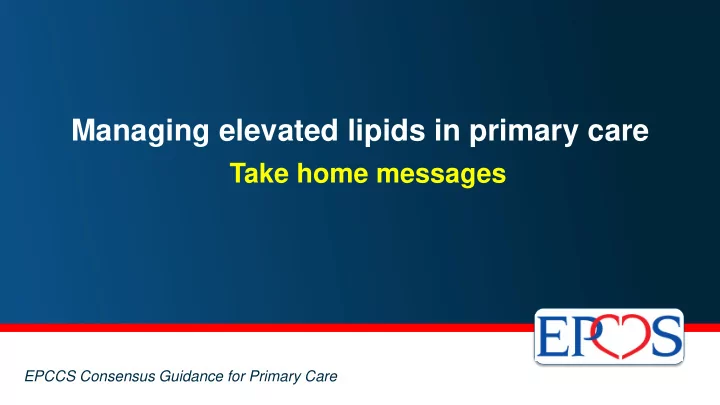

Managing elevated lipids in primary care Take home messages EPCCS Consensus Guidance for Primary Care
EPCCS consensus guidance on managing elevated lipids: take home messages Evidence for lipid-lowering therapy to lower CV risk LDL-c LDL-c is an atherogenic particle and major risk factor for CVD Lowering LDL-c reduces CVD events substantially and consistently LDL-c is currently the only lipid risk factor and an important treatment target to lower CVD risk Other lipids and lipoproteins: Currently not risk factors Can serve as risk markers, but are not treatment targets Slide set accompanying the EPCCS Consensus Guidance for Primary Care, on Managing elevated lipids. Downloadable from IPCCS.org
EPCCS consensus guidance on managing elevated lipids: take home messages CV risk assessment Different treatment goals have been defined for different risk factors CV risk assessment tools can guide management decisions and prevent under- and overtreatment SCORE risk tables may underestimate risk in young persons and overestimate risk in elderly persons - in young : speak of risk age or lifetime risk - in elderly : use risk calculator specifically developed for elderly patients Slide set accompanying the EPCCS Consensus Guidance for Primary Care, on Managing elevated lipids. Downloadable from IPCCS.org
EPCCS consensus guidance on managing elevated lipids: take home messages Management options for hypercholesteremia (1/2) Lifestyle modification Limit dietary fatty acids intake Saturated and trans fatty acids should be lower than 10% and 1% of total energy intake, respectively. Effect of dietary cholesterol is less clear, and less prominent than that of saturated and transfatty acids. Dietary fibre intake (25-30 g/day) can lower total cholesterol and LDL-c Body weight control can lower total cholesterol, LDL-c and triglycerides Physical activity mostly increases HDL-c and lowers triglycerides Slide set accompanying the EPCCS Consensus Guidance for Primary Care, on Managing elevated lipids. Downloadable from IPCCS.org
EPCCS consensus guidance on managing elevated lipids: take home messages Management options for hypercholesteremia (2/2) Pharmacological treatment: First-line treatment: Statins at the highest tolerable dose in high-risk patients with LDL-c > 3.0 mmol/L (116 mg/dL) Additional lipid-lowering agents if treatment targets are not met Slide set accompanying the EPCCS Consensus Guidance for Primary Care, on Managing elevated lipids. Downloadable from IPCCS.org
EPCCS consensus guidance on managing elevated lipids: take home messages Currently available lipid-lowering therapies Statins are the first choice of treatment and should be titrated to the highest tolerated dose Clinical benefit of combination therapy has only been demonstrated of treatment with ezetimibe and statins, and of PCSK9 inhibitors on top of statins with or without ezetimibe The impact of LDL-c lowering on reduction of major vascular events is similar across the spectrum of LDL-c levels Statins Ezetimibe Very low LDL-c levels (<0.65 mmol/L [<25 mg/dL]) as achieved with PCSK9 inhibitors have been found to be safe, although long-term safety remains to be PCSK9 inhibitors established Slide set accompanying the EPCCS Consensus Guidance for Primary Care, on Managing elevated lipids. Downloadable from IPCCS.org
EPCCS consensus guidance on managing elevated lipids: take home messages Challenges faced in clinical reality The majority of patients eligible for lipid-lowering therapy are not treated with adequate statin therapy Statin therapy is remarkably safe. In case of (perceived) statin intolerance, rechallenging with another statin or a lower dose, is a succesful strategy Negative media attention on statins can affect therapy adherence, but so can positive stories Big data methods increasingly allow to categorise patients more precisely and to tailor therapy to an individual’s need and risk Slide set accompanying the EPCCS Consensus Guidance for Primary Care, on Managing elevated lipids. Downloadable from IPCCS.org
Recommend
More recommend